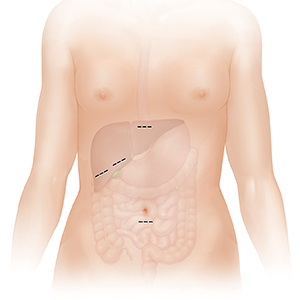A
B
C
D
E
F
G
H
I
J
K
L
M
N
O
P
Q
R
S
T
U
V
W
X
Y
Z
Topic IndexLibrary Index
Click a letter to see a list of conditions beginning with that letter.
Click 'Topic Index' to return to the index for the current topic.
Click 'Library Index' to return to the listing of all topics.
Having Laparoscopic Cholecystectomy
You’ve had painful attacks caused by gallstones. Because of this, you are having surgery to remove your gallbladder. This is called cholecystectomy. A method called laparoscopy will be used. This allows surgery to be done through a few small cuts (incisions).
 |
| Possible incision sites. |
Before your surgery
-
Tell your provider what medicines you take. This includes prescription medicines, over-the-counter medicines, illegal drugs, herbs, vitamins, and other supplements. Be sure to mention if you take prescription blood thinners. This includes warfarin, clopidogrel, ibuprofen, and aspirin. You may be asked to stop taking certain medicines several days before surgery.
-
If you drink alcohol, tell your provider how much you drink. This is very important if you are a heavy drinker or have had alcohol withdrawal symptoms in the past. Alcohol withdrawal can be dangerous. But the symptoms can be safely managed if your healthcare provider knows your alcohol history.
-
Have any tests your provider asks for, such as blood and urine tests and an electrocardiogram (ECG).
-
Don’t eat or drink after midnight the night before your surgery. This includes water, coffee, and mints.
-
Wash with a special scrub, if you are told to do so.
The day of surgery
When you arrive, you will prepare for surgery:
-
An IV (intravenous) line will be put into a vein in your arm or hand. This IV line is the way you are given fluids and medicine.
-
An anesthesiologist will talk with you about anesthesia. This is medicine used to prevent pain. You will receive general anesthesia. This puts you into a deep sleep-like state through the procedure.
During laparoscopic surgery
For this surgery, a thin tube with a tiny camera is used. This is called a laparoscope. The scope sends images from inside your body to a video screen. This lets the surgeon view and work on your gallbladder:
-
Small incisions are made in your belly (abdomen). The scope is put through 1 of the incisions. Surgical tools are put through other incisions.
-
Small clips are used to close off the connection between the gallbladder and the bile duct. The gallbladder is then detached from the liver.
-
The gallbladder is removed through 1 of the incisions. Bile still flows from the liver to the small intestine.
-
When the surgery is done, all tools are removed. Incisions are closed with stitches (sutures), surgical glue, or staples.
Sometimes, a laparoscopic surgery may need to be changed to an open surgery. This method uses 1 large incision. This change may happen because of scar tissue, unusual anatomy, or for some other unexpected reason.
After surgery
You will be sent to the post-anesthesia care unit (PACU) to be closely monitored. You will likely go home the same day. In some cases, an overnight stay is needed. When you are released to go home, have a family member or friend ready to drive you.
Risks of this surgery
All surgeries have risks. The risks of gallbladder surgery include:
Online Medical Reviewer:
Jen Lehrer MD
Online Medical Reviewer:
Raymond Kent Turley BSN MSN RN
Online Medical Reviewer:
Rita Sather RN
Date Last Reviewed:
2/1/2022
© 2000-2025 The StayWell Company, LLC. All rights reserved. This information is not intended as a substitute for professional medical care. Always follow your healthcare professional's instructions.